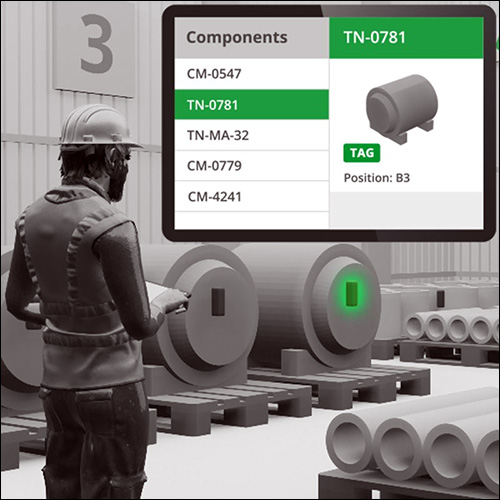- UWB Tags Lighting the Way
- Preventing Forklift Collisions
- Gaining Transparency Across Logistics and Production

Sewio’s RTLS Studio 2.6 backchannel feature enables “pick-by-light.”
Logistics and manufacturing companies have been building solutions around a new feature in ultra-wideband (UWB) real-time location system (RTLS) technology that allows them to interact in two-way communication with tags. Sewio‘s RTLS Studio 2.6 backchannel feature opens up new use cases for the technology, the company reports, by allowing users to “talk” to their tags.
There are multiple use cases for this feature, Sewio says, but the primary one is the “pick-by-light” feature, with which an operator can trigger a specific tag to flash an LED light, providing a quick visual cue to help them find it. The company’s goal is to save time and labor employees previously spent searching for tools or components in production, or inventory in the pick-and-pack process. One of the first businesses to build the new feature into their solutions is SICK, which offers its customers solutions aimed at improving processes from intra-logistics through product manufacturing.
Sewio built the backchannel feature on top of the standard UWB time-distance-of-arrival (TDoA) method of locating a tag (TDoA leverages one-way communication). With the standard process, the tags transmit between 3.1 and 10.6 GHz to Sewio anchors installed throughout a facility, which identify the location and forward that data to a server. In such traditional networks, users cannot communicate with the tags. However, by building two-way communication capability via software and tag firmware upgrades, Sewio intends to open up new applications for the technology.
By allowing tags to receive instructions, the UWB deployments would make production processes easier and faster, reduce the need for RTLS anchors around the facility, and enable safety benefits, according to Petr Passinger, Sewio’s chief marketing officer. Among such use cases, he says, Sewio’s RTLS Studio 2.6 features the “pick-by-light” feature, with the flashing LED triggered via Sewio’s standard RTLS Manager user interface or via an API.
UWB Tags Lighting the Way

Petr Passinger
With a traditional UWB system, users could view a tagged item’s location in their software or app, within a range of approximately 30 centimeters (11.8 inches). They could then use the location data, such as a blue dot on a warehouse map, to proceed to that spot and select the item—for example, a coil required for the manufacturing of an industrial product. Even that location data may not be specific enough, however, if many coils are packed near each other, and if they are not all the same size or model. “It’s still quite hard for you to identify the right one,” Passinger says, and this creates the potential for time delays and errors.
With the pick-by-light feature, users would employ the RTLS Manager feature in the RTLS Studio 2.6 software and simply flip the LED light on or off for a specific tag. The RTLS Manager app uses the REST application programming interface to send LED on or off requests via UWB transmissions. For example, warehouse operators could have the application open on a touch screen mounted on their forklifts. If they needed a specific coil, they would follow prompts in the app to turn on the light for that coil’s tag. The UWB data could provide the approximate location so the operators would clearly see the light illuminated, go to that coil, select it and deliver it where it was needed.
Users can configure the tags to blink their light at specified times or according to certain events—for instance, if a span of three days has passed since the tag was placed in the warehouse. That feature, according to Sewio, could ensure that products were moved through the warehouse in a timely fashion before reaching their expiration dates. Software users could view each tag’s status as having received instructions to blink its light (and thus lighting up) or not having received the message.
Preventing Forklift Collisions
The second most common use case for the backchannel feature, Passenger says, is safety. If workers were wearing UWB tags, built into their vest or wristband, they could have two-way communication with the safety software. If a moving forklift came within range of an employee’s tag, the UWB software would identify that event and issue an alert, not only to the forklift operator but also to the worker wearing the tag. The tag could then flash its LED in warning, or a buzzer could alert that person on a wristband. The forklift driver could see an alert message on their display at the same time the worker’s vest tag or wristband raised the alert.

Roland Avar
Another use case centers around configuring electronics. If a tablet or other item comes with a UWB tag from Sewio, the tag provides a means of communication with the electronics built into the product. Companies can reconfigure the product’s settings through instructions sent to the tag via UWB. For instance, if a company wanted all tablets packed in a specific batch to be configured for Spanish language, such a command could be sent via the UWB anchor to those specific tagged items.
When it comes to locating products, Passinger says, the technology could enable users to identify where tagged items were with less granular location data, since the illuminated LED would direct them to those products. In that way, he explains, the technology could be used with as little as one UWB anchor—if specific location data wasn’t required—to transmit the LED lighting instructions. Thus, for a minimal cost, users could set up the system within a warehouse, storage area or retail location, with a single anchor and an unlimited number of tags.
Sewio sells three types of UWB FS tags that include LEDs. Thus, users of an existing RTLS Studio 2.6 system with version FS anchors and tags could upgrade the technology to include the two-way feature using Sewio’s Tag Leonardo Configurator app (version 1.3.2 or newer), then employ the built-in “Blink Profile” setting. “We actually open the firmware [for use by developers],” Passinger states, “so our partners can write their own custom extensions using the two-way communication.”
SICK says it provides sensor intelligence and application solutions for more efficient and safer processes. The company has begun developing solutions to help its customers more easily manage supplies, materials and tools through supply chains and assembly. The firm and Sewio agreed to bring the new feature to the market this spring, according to Roland Avar, SICK’s product management head.
Gaining Transparency Across Logistics and Production
Companies leveraging or testing the SICK technology come from two common sectors, Avar reports: intra-logistic and production logistics. “We see that production and intralogistics are in harmony,” he states. While they were once considered two distinct disciplines, “Now these areas are growing closer and closer together, thanks to advances in automation and digitalization. Making the material flow completely transparent, from the materials being delivered to delivering the finished product, is the goal here.”
The prerequisite for smart networked production is ultimately knowing where everything is located at all times. For SICK, Avar says, bi-directional communication was important to have, “as we also [offer] a pick-by-light [solution], or just to use the communication channel for additional customer-centric or even application-centric event-based business logic.” With pick-by-light, he adds, “Our customers can quickly distinguish the desired asset from numerous others in the physical location.”
SICK offers the bi-directional feature with its own Asset Analytics localization software. For example, users could deploy the software to set up parameters through a digital map feature and virtual geozones, provided as part of Asset Analytics. The system could identify when a tag left or entered a zone in an unauthorized action, as well as distinguish that action from an authorized movement.
If such a movement were authorized, the system could automatically book a new product into or out of that area. The LED light would respond to its location and exhibit different behaviors, depending on the event underway. For those deploying the solution, Avar says, it has reduced search times by havening visualization LED behavior, thereby guiding workers to the exact assets they seek. That not only saves time and labor, he notes, but also prevents errors.
Key Takeaways:
- Two-way directionality allows companies to instruct tags on products or tools to light up.
- A host of other applications result from two-way transmissions, such as alerting employees with UWB vest tags of potential hazards, or instructing electronics to adjust their settings.
Exhibitors at RFID Journal LIVE! 2022 will offer UWB solutions for logistics and manufacturing applications. To learn more, visit the event’s website.


